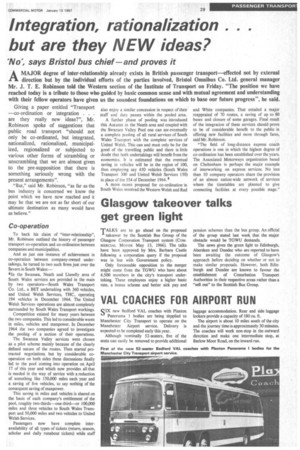Integration, rationalization but are they NEW ideas?
Page 31

If you've noticed an error in this article please click here to report it so we can fix it.
'No', says Bristol bus chief—and proves it
AMAJOR degree of inter-relationship already exists in British passenger transport—effected not by external direction but by the individual efforts of the parties involved, Bristol Omnibus Co. Ltd. general manager Mr. J. T. E. Robinson told the Western section of the Institute of Transport on Friday. "The position we have reached today is a tribute to those who guided by basic common sense and with mutual agreement and understanding with their fellow operators have given us the soundest foundations on which to base our future progress", he said.
Giving a paper entitled "Transport —co-ordination or integration . . are they really new ideas?", Mr. Robinson spoke of suggestions that public road transport "should not only be co-ordinated, but integrated, nationalized, rationalized, municipalized, regionalized or subjected to various other forms of scrambling or unscrambling that we are almost given to the pre-supposition that there is something seriously wrong with the present arrangements".
"But," said Mr. Robinson, "as far as the bus industry is concerned we know the point which we have now reached and it may be that we are not as far short of our ultimate destination as many would have us believe."
Co-operation
To back his claim of "inter-relationship", Mr. Robinson outlined the history of passenger transport co-operation and co-ordination between companies and municipalities.
And as just one instance of achievement in co-operation between company-owned undertakings, he turned to two such firms just over the Severn in South Wales:—
'In the Swansea, Neath and Llanelly area of South Wales services are provided in the main by two operators—South Wales Transport Co. Ltd., a BET undertaking with 360 vehicles, and United Welsh Services, THC, operating 194 vehicles in December 1964. The United Welsh Services operations are almost completely surrounded by South Wales Transport workings.
Competition existed for many years between the two companies. This led to considerable waste in miles, vehicles and manpower. In December 1964 the two companies agreed to investigate the pooling of a section of their operations.
The Swansea Valley services were chosen as a pilot scheme mainly because of the clearly defined nature of the routes. Then started protracted negotiations but by considerable cooperation on both sides these discussions finally led to the pool coming into operation on April 17 of this year and which now provides all that is needed in the way of service with a reduction of something like 150,000 miles each year and a saving of five vehicles, to say nothing of the consequent saving of manpower.
This saving in miles and vehicles is shared on the basis of each company's entitlement of the pool, roughly two-thirds--one-third—or 100,000 miles and three vehicles to South Wales Transport and 50,000 miles and two vehicles to United Welsh Services.
Passengers now have complete interavailability of all types of tickets (return, season, scholar and daily runabout tickets) while staff also enjoy a similar concession in respect of their staff and duty passes within the pooled area.
A further phase of pooling was introduced this Autumn in the Neath area and coupled with the Swansea Valley Pool one can sec eventually a complete pooling of all rural services of South Wales Transport with the complete services of United Welsh. This can and must only be for the good of thc travelling public and there is little doubt that both undertakings will benefit from the economies. It is estimated that the eventual saving in vehicles will be in the region of 100, thus employing say 450 vehicles (South Wales Transport 300 and United Welsh Services 150) in place of the 554 of December 1964. 9 A more recent proposal for co-ordination in South Wales involved the Western Welsh and Red
and White companies. That entailed a major reappraisal of 70 routes, a saving of up to 80 buses and closure of some garages. Final result of the integration of these services should prove to be of considerable benefit to the public in offering new facilities and more through fares, said Mr. Robinson.
"The field of long-distance express coach operations is one in which the highest degree of co-ordination has been established over the years. The Associated Motorways organization based on Cheltenham is perhaps the major example of interworking on express services. No less than 10 company operators share the provision of an almost nation-wide network of services where the timetables are planned to give connecting facilities at every possible stage."








































































































